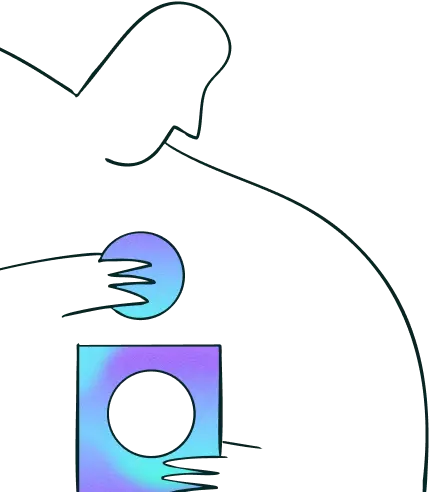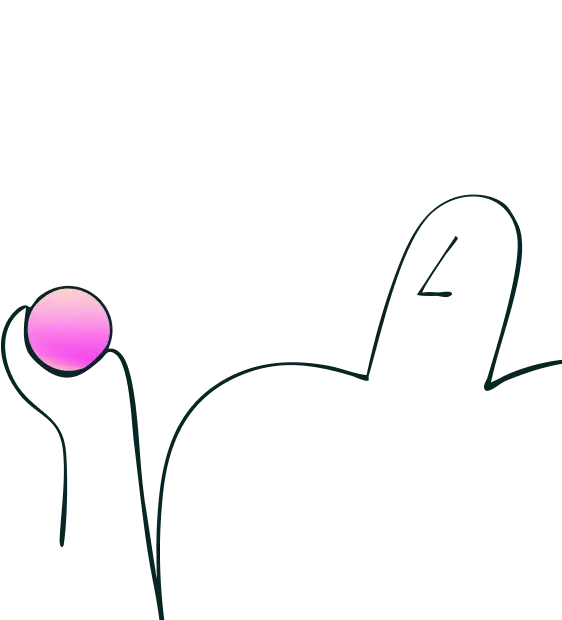30 May 2025
|12 min
Product design vs user experience design
We explore the key similarities and differences between product design and UX design in terms of responsibilities, skills, and salary.

You’re ready to take the next step in your design career and apply for a user experience (UX) design position.
While looking at listings for UX designer jobs, you notice some companies are also looking for product designers. You even found one listing for a "UX product designer".
You find yourself more confused as you scroll through job descriptions for UX design and product design jobs. You see similarities, but you also spot some differences in their day-to-day responsibilities.
Now, you’re stuck between applying for UX designer vs product designer roles. You end up with a whole host of questions.
Can you get into product design if your portfolio is centered on UX design? Or can someone with product design experience also apply for UX design roles? How about UI/UX vs product design?
This guide has the answers to these questions and will help you decide which role is right for you. You’ll learn about the:
Key differences and similarities between product design and UX design.
Details on product designer vs UX designer in terms of responsibilities, skills needed to do the job, and average salaries.
Product design vs UX design: Key differences and similarities
Product design is more involved in the overall design process of a product or service, while UX design zooms in on the user journey while using a product.
While both can overlap in product development, there are nuances in how both concepts are similar and different from each other. The first step to identifying their subtle similarities and differences is understanding each concept.
In a hurry? The table below summarizes what you need to know about product design vs UX design.
Comparison | Product design | UX design |
|---|---|---|
Underlying framework | Design thinking. | Design thinking. |
Research methods | Qualitative and quantitative research methods. | Qualitative and quantitative research methods. |
Main objectives | • Looks at the product from a business perspective. • Aims to meet both users’ needs and business goals, which help brands create successful products consistently. | • Looks at the product from a usability and usefulness perspective. • Aims to ensure that the product, service, or system fulfils users’ needs. |
How each role benefits businesses | • Defines product goals. • Creates product roadmaps. • Releases successful products in the long-term. • Maintains product desirability. | • Converts leads to existing customers. • Improves customer satisfaction. • Drives brand loyalty. • Retains existing customers. |
What is product design?
Product design has its roots in the practice of industrial design. Originally used to describe designing tangible products, product design teams nowadays also cover digital product development and services.
Product design follows the design thinking process to meet both users' needs and business goals, which helps brands create successful products consistently.
Learn more: what is customer experience design
Here are some questions that product designers answer:
Is there a market opportunity for this product?
Does this product solve an existing problem in the market?
Does this product align with the business' short-term goals and long-term vision?
How can we make this product cost-effective?
What will this product look like in two years?
In short, product design helps companies:
Define their product goals.
Create product roadmaps.
Release successful products in the long-term.
Maintain product desirability.
What is UX design?
In contrast to product design, which has been around for a while now, the term UX design is relatively new.
User experience design aims to ensure that a product, service, or system fulfills users’ needs. Through the design thinking process (the same process that product designers use), a UX designer advocates for users and aims to understand the overall experience of users as they interact with the product.
Here are some questions that UX designers answer:
Do customers need this product?
How does this product help users?
Is this specific feature helpful?
How do we make this product more accessible to different users?
How do we make this product more usable and valuable for the customer?
Put simply, UX design helps companies:
Convert leads into existing customers.
Improve customer satisfaction.
Drive brand loyalty.
Retain existing customers.
What about UI design?
You’ve probably heard about user interface (UI) design and come across companies that are looking for UX/UI designers.
UI designers are responsible for designing interfaces that help ensure a smooth user experience. These include images, animation, typography, buttons, and a site’s visual hierarchy.
Think of it this way: UI design focuses on the look and feel of the product, while UX design concentrates on the usability and accessibility of the product.
Learn more: What is UX vs UI design? The differences explained.
Product design vs UX design in a nutshell
Now that you have an idea of product design and UX design as a practice, here’s how they’re similar and different from each other.
What are the similarities?
The similarities between what a product designer does and what a UX designer does boil down to the following:
Both rely on the design thinking process to create products that solve users’ problems, provide more helpful experiences, and fill a gap in the market.
Both may employ the same set of UX tools and methodology to accomplish their respective goals. For instance, a UX designer and a product designer may conduct user interviews and competitor research to gather insights during the initial stages of the design thinking process. Another example is that both disciplines benefit from the same set of tools like wireframes, prototypes, and user testing platforms like Lyssna. In the context of designing digital products, particularly SaaS applications, mastering saas ux ui design and development can significantly enhance both usability and business outcomes.
What are the differences?
The differences between what a product designer does and what a UX designer does can be narrowed down to the following:
Product designers are often business-oriented, while UX designers tend to focus on the user experience. Although both roles are essential for the success of a product, their priorities are slightly different.
Product designers tend to be generalists in design teams and can take the lead in the design process. This is in contrast to the more narrow focus of UX designers.
In short, product design is more all-encompassing. Product designers look at the product from a business perspective. They pay more attention to competitors, industry trends, and stakeholder needs.
Meanwhile, UX design is more focused on the usability and usefulness of a product. UX designers designers look at the product from a user’s perspective and pay more attention to customer journeys within the product, which is especially critical in sectors like ux design for fintech, where trust and usability are key
However, this doesn’t mean that UX designers have no concern for business priorities and that product designers don’t consider users’ needs. Both types of designers can work together to ensure product-market fit and help businesses grow.
Elevate your research practice
Join over 320,000+ marketers, designers, researchers, and product leaders who use Lyssna to make data-driven decisions.
Product designer vs UX designer: Responsibilities, skills, and salaries
If you’re still unsure if a product designer or a UX designer role is the right fit for you, let’s look at how both roles compare in terms of what they do, their skillset, and salaries.
Comparison | Product designer | UX designer |
|---|---|---|
Product development focus | Broader involvement in the design and development of a product. | Narrower focus than product designers in the design and development of a product. |
Areas of attention | • Looks at the product more from a business perspective. • Pays more attention to competitors, industry trends, and stakeholder needs. | • Looks at the product more from a user’s perspective. • Pays more attention to customer journeys within the product. |
Technical skills required | User research, usability testing, proficiency in design and 3D modeling tools, wireframing, interaction design, and a strong understanding of UX design principles and design thinking. | Mapping user journeys, cognitive psychology, qualitative and quantitative research, user research, usability testing, proficiency in design and 3D modeling tools, wireframing, graphic design, interaction design, and a strong understanding of UX design principles and design thinking. |
Soft skills required | Problem-solving, empathy, negotiation, collaboration across teams, leadership and project management, public speaking. | Problem-solving, empathy, collaboration across teams, presentation, project management. |
Past work experience | UX designer, project manager, product owner. | UI designer, graphic designer, visual designer, UX researcher, interaction designer, ethnographer. |
Average salary as of 2022 (USD) | $94,234 | $97,848 |
What does a product designer do on a daily basis?
A product designer’s responsibilities and day-to-day may include the following:
Identify opportunities for new products, services, or features.
Gather information and evaluate how a new product or feature might tie into existing business goals and customer demographics.
Prepare and confirm design specifications based on briefs from internal and external stakeholders, often by creating detailed design proposals to align everyone on the vision and scope.
Create product roadmaps.
Sketch and test the functionality of prototypes.
Improve the design of existing products and services.
Gather feedback from users.
Share and present ideas and findings to stakeholders and partners.
Set schedules and deadlines for project completion.
Plan for design budgets.
Learn more: A day in the life of a product designer.
What skills and training do you need to become a product designer?
Companies looking for product designers are likely to look for the following combination of skills:
Technical skills: User research, usability testing, proficiency in design and 3D modeling tools, wireframing, interaction design, and a strong understanding of UX design principles and design thinking.
Soft skills: Problem-solving, empathy, negotiation, collaboration across teams, leadership and project management, public speaking.
Average product designer salary
Here’s how much product designers earn on average (as of December 2022):
United States: USD$94,234 (GlassDoor)
Canada: CAD$78,843 (Indeed Canada)
Australia: AUD$114,464 (Indeed Australia)
United Kingdom: £51,453 (Glassdoor UK)
China: ¥200,000 (Payscale)
Singapore SGD$66,129 (Levels)
Germany €46,782 (Payscale)
What does a UX designer do on a daily basis?
A UX designer’s responsibilities and day-to-day may include the following:
Perform user research through interviews and usability testing.
Gather quantitative data through product usage reports and analytics.
Create and develop user personas, storyboards, wireframes, and task flows based on user research results, and define user flows.
Understand product design specifications and implement them.
Collaborate with product designers, UI designers, user researchers, UX writers, and product development teams.
Provide and seek feedback from stakeholders, developers, marketers, and customer support teams.
Learn more: A day in the life of a senior UX designer at IKEA.
What skills and training do you need to become a UX designer?
Design teams are likely to look for the following combination of skills:
Technical skills: Mapping user journeys, cognitive psychology, qualitative and quantitative research, user research, usability testing, proficiency in design and 3D modeling tools, wireframing, graphic design, interaction design, and a strong understanding of UX design principles and design thinking.
Soft skills: Problem-solving, empathy, collaboration across teams, presentation, project management.
Average UX designer salary
Here's how much UX designers earn on average (as of December 2022):
United States: USD$97,848 (Glassdoor)
Canada: CAD$86,533 (Indeed Canada)
Australia: AUD$107,745 (Indeed Australia)
United Kingdom: £53,303 (Glassdoor)
China: ¥171,000 (Payscale)
Singapore SGD$48,876 (Payscale)
Germany €45,106 (Payscale)
Product design or UX design: Which role is the best fit for you?
When deciding between the two roles, it depends on whether you want to have broader business involvement in creating and developing a product (product design) or prefer to zoom in on how users use the product (UX design).
One of the most rewarding aspects of being a product designer is that you have more opportunities to innovate. Meanwhile, UX designers have a crucial role in enhancing customer satisfaction.
For both roles, it's important to be well-versed in foundational UX principles and the design thinking framework. Plus, there’s an overlap in the tools, skills, and methodologies used by both product designers and UX designers.
Whether you prefer product design or UX design, head over to our helpful guides on the different testing processes used by UX designers and product designers. And when you're ready to get started and test your designs, Lyssna has all the tools you need – try it for free.
Your go-to user research platform
The best teams use Lyssna so they can deeply understand their audience and move in the right direction — faster.
Frequently asked questions about product design vs UX design
--
Kai has been creating content for healthcare, design, and SaaS brands for over a decade. She also manages content (like a digital librarian of sorts). Hiking in nature, lap swimming, books, tea, and cats are some of her favorite things. Check out her digital nook or connect with her on LinkedIn.
You may also like these articles


Try for free today
Join over 320,000+ marketers, designers, researchers, and product leaders who use Lyssna to make data-driven decisions.
No credit card required






